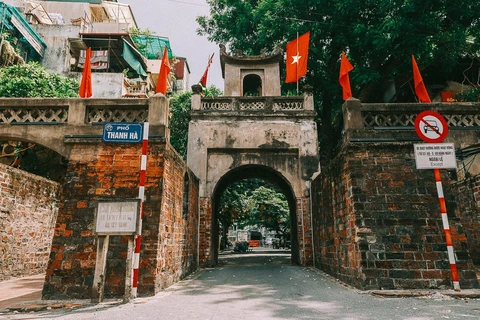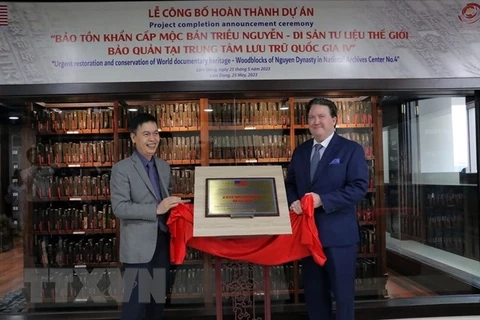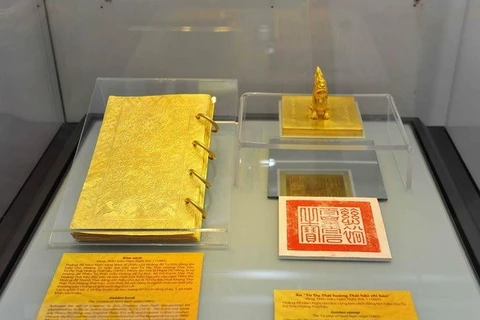Thua Thien-Hue (VNA) – Results of an over-one-month archaeological excavation of Can Chanh Palace, part of the Hue Imperial Citadel in the central province of Thua Thien-Hue, were revealed on August 23.
Hue served as the capital of Vietnam during the Nguyen Dynasty (1802 - 1945), the last feudal in Vietnam, by the name of Phu Xuan.
Findings from archaeological holes, covering about 200 sq.m. in total, show changes in the palace foundation during different restoration periods since it was built under the reign of King Gia Long (1762 - 1820).
According to archaeologists’ preliminary conclusions, Can Chanh Palace was built on a weak geological background, possibly an area of lakes or swamps in the past, so its foundation was reinforced during restoration periods in history.
Nguyen Ngoc Chat, deputy head of the research and collection division of the Vietnam National Museum of History, said from its construction in 1804 to its destruction in 1947, the palace underwent 11 rehabilitations at different levels.
Some experts recommended restoring the palace to the status it was under the reign of King Khai Dinh (1885 - 1925) as it was one of the most beautiful architectural structures of the Nguyen Dynasty at that time.
Hoang Viet Trung, Director of the Hue Monuments Conservation Centre, said conducting archaeological studies is a compulsory step during the restoration of relic sites. This time’s excavation has provided much scientific data supplemented to a study serving the palace restoration.
Can Chanh Palace has been researched for more than two decades, with support from experts of Japan’s Waseda University. The conservation centre will strive to complete procedures soon so as to start the restoration project in 2024, he added.
The palace was a site where Nguyen kings worked and granted audiences to mandarins. It was destroyed in February 1947, with only the foundation left.
In 2021, the Thua Thien-Hue provincial People’s Council approved a project on Can Chanh Palace rehabilitation with estimated total investment of 200 billion VND (8.3 million USD) funded by the provincial budget.
Hue city is home to five world heritages, namely the Complex of Hue Monuments, Nha Nhac (Vietnamese court music), the woodblocks of the Nguyen Dynasty, the imperial archives of the Nguyen Dynasty, and the royal literature on the Hue royal architecture./.
Hue served as the capital of Vietnam during the Nguyen Dynasty (1802 - 1945), the last feudal in Vietnam, by the name of Phu Xuan.
Findings from archaeological holes, covering about 200 sq.m. in total, show changes in the palace foundation during different restoration periods since it was built under the reign of King Gia Long (1762 - 1820).
According to archaeologists’ preliminary conclusions, Can Chanh Palace was built on a weak geological background, possibly an area of lakes or swamps in the past, so its foundation was reinforced during restoration periods in history.
Nguyen Ngoc Chat, deputy head of the research and collection division of the Vietnam National Museum of History, said from its construction in 1804 to its destruction in 1947, the palace underwent 11 rehabilitations at different levels.
Some experts recommended restoring the palace to the status it was under the reign of King Khai Dinh (1885 - 1925) as it was one of the most beautiful architectural structures of the Nguyen Dynasty at that time.
Hoang Viet Trung, Director of the Hue Monuments Conservation Centre, said conducting archaeological studies is a compulsory step during the restoration of relic sites. This time’s excavation has provided much scientific data supplemented to a study serving the palace restoration.
Can Chanh Palace has been researched for more than two decades, with support from experts of Japan’s Waseda University. The conservation centre will strive to complete procedures soon so as to start the restoration project in 2024, he added.
The palace was a site where Nguyen kings worked and granted audiences to mandarins. It was destroyed in February 1947, with only the foundation left.
In 2021, the Thua Thien-Hue provincial People’s Council approved a project on Can Chanh Palace rehabilitation with estimated total investment of 200 billion VND (8.3 million USD) funded by the provincial budget.
Hue city is home to five world heritages, namely the Complex of Hue Monuments, Nha Nhac (Vietnamese court music), the woodblocks of the Nguyen Dynasty, the imperial archives of the Nguyen Dynasty, and the royal literature on the Hue royal architecture./.
VNA

























